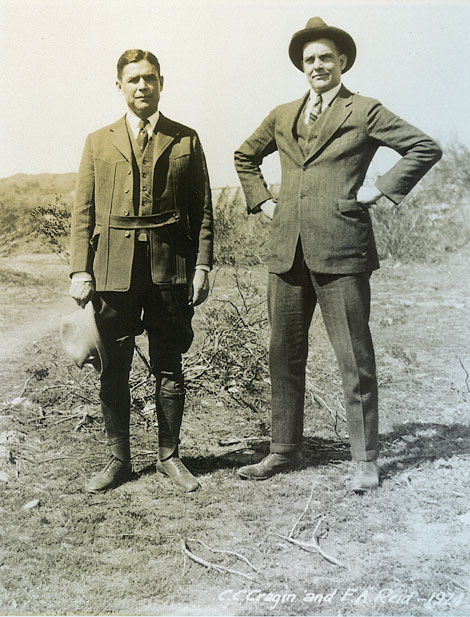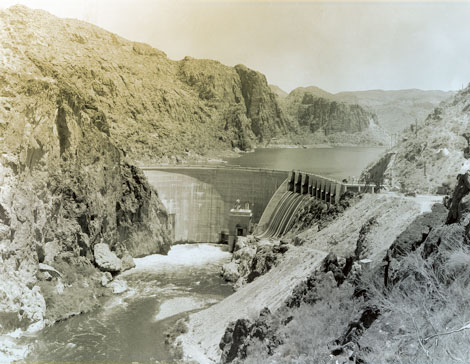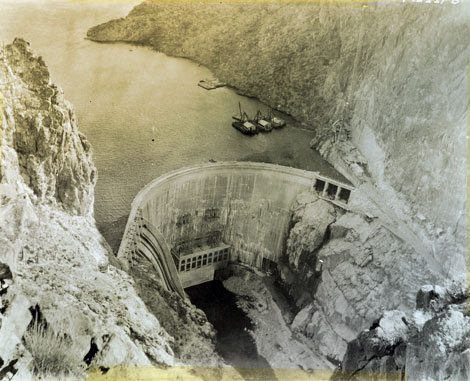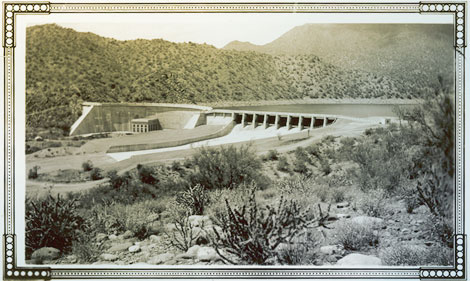

 Superintendent Charles C. Cragin (left) and SRP President Frank Reid played key roles in moving the Salt River Valley Water Users' Association into the power generation business. Cragin's plan for building three new dams on the lower Salt River ensured that the Association would become a major hydroelectric supplier for the Salt River Valley. (SRP photograph)
Superintendent Charles C. Cragin (left) and SRP President Frank Reid played key roles in moving the Salt River Valley Water Users' Association into the power generation business. Cragin's plan for building three new dams on the lower Salt River ensured that the Association would become a major hydroelectric supplier for the Salt River Valley. (SRP photograph) Mormon Flat Dam was the first of the hydroelectric dams to be built on the Salt River. (SRP photograph)
Mormon Flat Dam was the first of the hydroelectric dams to be built on the Salt River. (SRP photograph) The second dam to be built by the Association was Horse Mesa Dam, located between Mormon Flat and Roosevelt dams. (SRP photograph)
The second dam to be built by the Association was Horse Mesa Dam, located between Mormon Flat and Roosevelt dams. (SRP photograph)"We are in the power business." SRP president Frank Reid's bold statement came while seeking Salt River Valley Water Users' Association (Association) shareholder approval for the Cragin Plan. In the early 1920s, General Superintendent Charles C. Cragin developed a power expansion program, complete with a financial plan for construction of three hydroelectric dams on the lower Salt River and a modern power transmission system. Cragin viewed hydroelectric expansion as essential for several reasons, including the increasing demand for low-cost hydroelectric power. He wanted to take advantage of a 1906 congressional act that allowed federal reclamation projects to sell surplus power. The Arizona Republican editorialized that passage of the Cragin Plan was the most important decision for the Salt River Valley since the effort to build Theodore Roosevelt Dam. Association shareholders resoundingly approved a bond issue to finance the program using shareholders' lands as collateral. Cragin designed all three dams with the assistance of the Bureau of Reclamation (Reclamation). The Mormon Flat, Horse Mesa and Stewart Mountain dams were built between 1923 and 1930. Although it took Reclamation more than six years to complete Roosevelt Dam, it took only seven years to raise three dams because of new technological and engineering advances. With the completion of the dams, SRP's hydropower generating capacity more than doubled and control of irrigation releases was greatly improved. SRP was able to use the power revenues generated by the three dams to pay back the federal government for Roosevelt Dam construction and for the bonds used to finance the new lower Salt River dams. Ultimately, Cragin's visionary plan enhanced SRP's power-generating capability, water storage capacity, and financial strength while continuing to provide reliable water to the Valley.
 Stewart Mountain Dam was the last dam to be built, completing the Association's decade-long effort to increase power generation. (SRP photograph)
Stewart Mountain Dam was the last dam to be built, completing the Association's decade-long effort to increase power generation. (SRP photograph)Taken from Standing for More Than a Century: Theodore Roosevelt Dam and SRP. pg 59. Salt River Project 2011.
